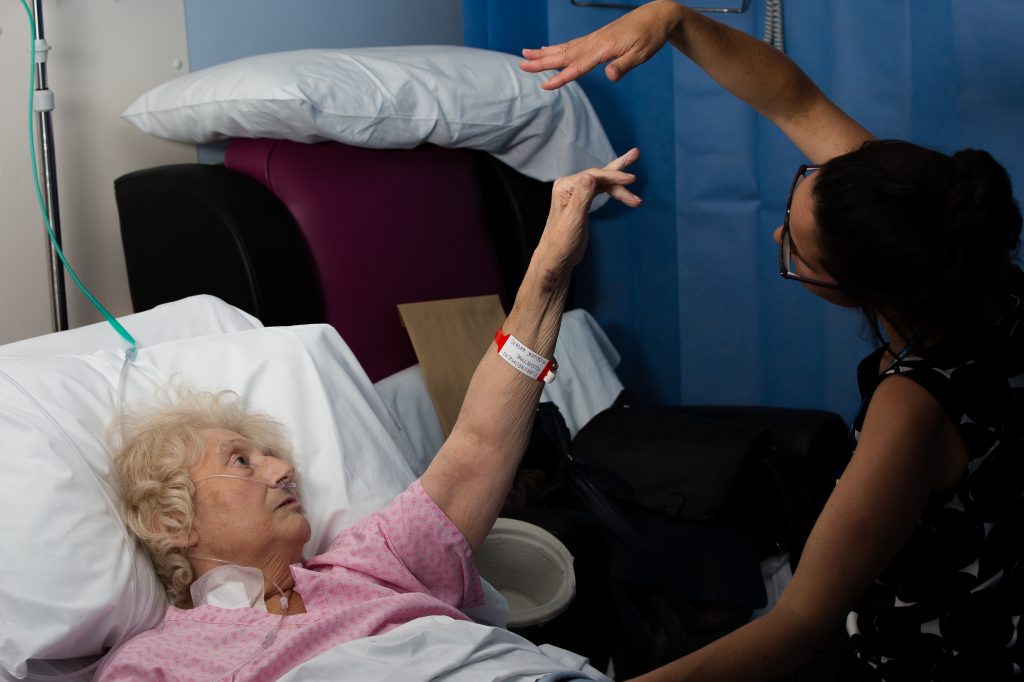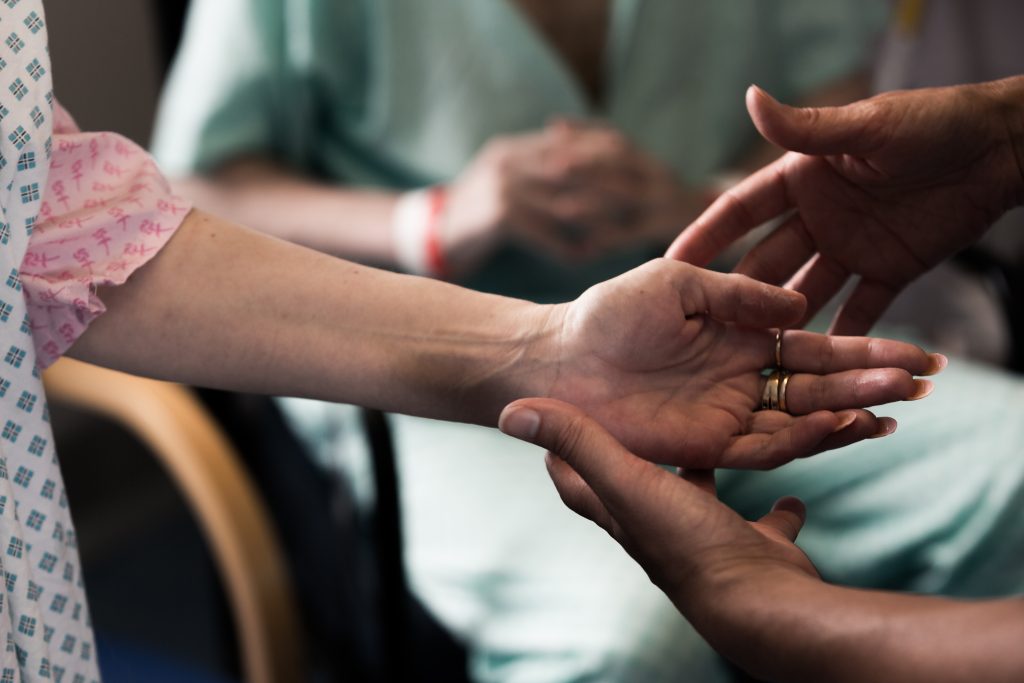The recent pandemic has flooded hospitals with high levels of new patients and visitors, all the while taking a tremendous toll on hospital staff’s personal and professional lives. With emergency and long-term healthcare facilities responsibly restricting nonessential activity, the role of art in inspiring health, wellbeing and solace takes renewed pertinence. This week’s Digital Dialogues asks: How does art engage with and respond to the urgency, intensity and fluctuations of the ongoing pandemic moment meaningfully, while also celebrating the triumphs, solidarity and dedication of healthcare communities?
On Tuesday, August 11, Futurecity Head of Strategy Andy Robinson and Curator Chloe Stagaman visited Cambridge Biomedical Campus, one of the world’s leading healthcare and biomedical research centres. The campus is home to over 18,000 patients, doctors, nurses, scientists, support staff and visitors, and is also the site of a 15,000+ sq.m public realm artwork, The Green and The Gardens, led by artist Ryan Gander OBE in collaboration with landscape designers Gillespies, and delivered by Futurecity in 2019 as part of a major expansion programme for Countryside and Liberty Property Trust.

As a highlight of their visit, Andy and Chloe spoke with Natalie Ellis, Head of Arts for Cambridge University Hospitals NHS Foundation Trust, about the effects of COVID-19 on the hospital art programmes she organises from the Cambridge Biomedical Campus:
FC: How has COVID-19 interrupted your regular hospital arts programming?
NE: The pandemic changed our programme overnight. 90% of our regular work was placed on “pause”, including our activities on wards, art collection care (we have 4500 pieces across the hospitals!), public exhibitions and performances. One of the big early questions was how we would continue doing the “day-to-day” that maintains the hospital as a comfortable, warm and welcoming place to be when our access is limited (we are now based at home).
There is also the input we give to new built environments, refurbishments and capital builds where we make sure that arts programmes and aesthetics are integrated. That has all halted for the time being. And then, of course, the most obvious impact has been on face-to-face artist contact with patients and families—a regular programme of theatre companies, roaming musicians and pop-up performances—which animate the hospital with arts. These have mostly halted as there can’t be extra people in the clinical spaces anymore for the safety of patients, staff and our community.
FC: Are there any elements of your programme that you’re starting to see return or launch as lockdown eases?
NE: Filipa Pereira-Stubbs, a dance artist based in Cambridge, is the lead on the flagship Cambridge University Hospitals’ arts programme Dance for Health. Last week, after close planning and coordination across the team, Pereira-Stubbs returned to the stroke and rehabilitation ward at Addenbrooke’s Hospital to work with patients. Her renewed presence offered patients the chance to unlock their emotions to somebody who isn’t a nurse or a doctor.
And on August 26, Addenbrooke’s will launch Colour in Motion, an exhibition in partnership with The Jerwood Collection and Paintings in Hospitals of the artist Ian Davenport’s radiant prints and paintings in our rehabilitation gymnasiums, which I am thrilled to unveil. It represents the first partnership we’ve done around art in rehabilitation spaces. The gymnasiums are already so bold with their colours, geometries and equipment and the artworks will complement and enhance the spaces.

FC: What does a commissioned artwork that responds to COVID-19 look like in a hospital setting?
NE: We’re dealing with the pandemic front on. Everyone who works with hospitals feels the ramifications of that. You want to be able to acknowledge the huge effort that everyone has contributed. No matter you’re line of work, we have been all-hands-on-deck to get through this. Ordinarily once you’ve been through something you would want to commemorate it, potentially with a piece of permanent work. Every hospital is thinking about this carefully and considering how to pay tribute to those that have been a part of the experience. I’m thinking about what can be done that’s temporary during this time and what opportunities the arts have to enable people to express their experiences, especially through artist residencies.
With Beyond the Mask, for example, we’ve celebrated the International Year of the Nurse & Midwife by inviting the public and staff to write poems about the pivotal and human moments at the hospital. In a short period of time we had very strong, completed poems. Two-thirds of them, at least, were from staff and included tales from their wards. The poetry allowed for a range of emotion including tragedy and moments of light. A professional poet also created online masterclasses and is currently bringing it all together to write his own poem in response.
FC: What do you think the legacy of COVID-19 will be for hospital and healthcare facility arts programmes?
NE: With arts, until you understand the needs of your community, you don’t know what you’re going to organise. As hospitals are such massive environments with various needs, this is an ongoing project. COVID-19 became a call to answer. Clearly there was a massive need to help front line staff. Some of them didn’t get to see their kids for weeks. You’re always thinking: OK, this is how we can respond. This is what is needed now. It has unlocked a lot of creative ideas and many of them have come from staff. For example, one day someone wrote me and said: ‘Just thinking it would be so good if we had a chalkboard in the sanctuary and people could just write up messages’. Before now ideas were restrained by procedure. Now, procedures are being rewritten and we are innovating every single day, and bringing colleagues with us. The circle doesn’t have to fit the square, always.
I feel positive about the connections we’ve made in areas of the hospital we haven’t reached before. Our profile has dramatically increased as the arts programme has become more focussed on direct engagement and participation. And through this we have learnt so much about our community. When you have 11,000 staff in your workforce, patients to think about and the wider community—who are all our patients from time to time—that can be quite overwhelming with an arts programme. You can seemingly go in any direction. So, this has given us a focus. There’s more to unite us now.
The arts programme Natalie Ellis organises is supported by Addenbrooke’s Charitable Trust. Have a question for Natalie after reading this interview? Feel free to contact her at [email protected]
READ MORE ABOUT FUTURECITY’S HEALTH & SCIENCE PORTFOLIO
